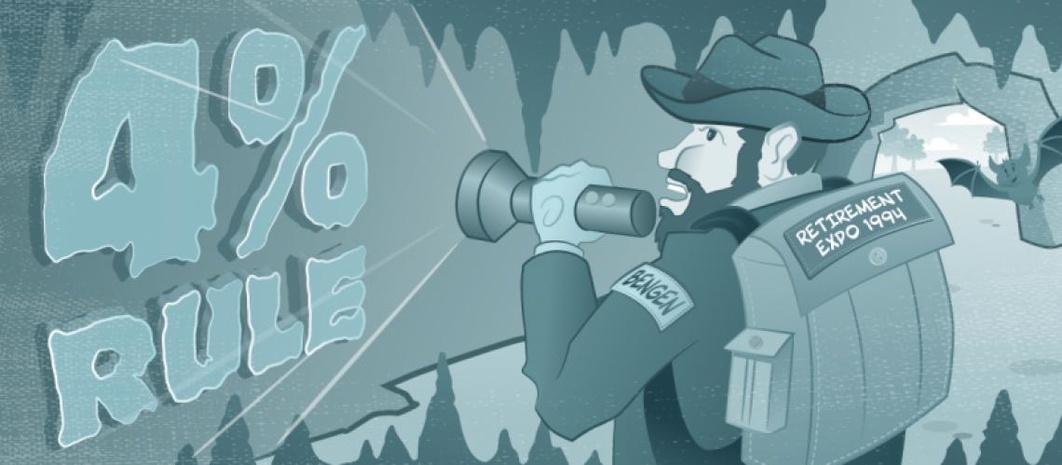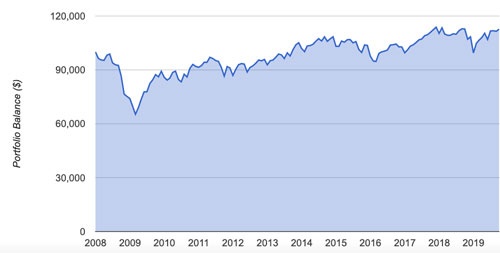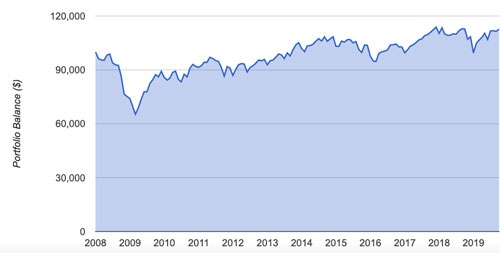
Andrew Hallam
05.11.2019
How Retirees Can Withdraw More Than 4 Percent Per Year
_
Elizabeth Shaw and Charlie Holloway were digging around in a Scottish cave. They discovered a special map that, they hoped, held the key to the origin of life on Earth. It was one of the earliest scenes in the science fiction thriller, Prometheus. And their discovery was a bit like the 4 percent rule.
OK, I might be stretching things a bit. But who’s to say William Bengen didn’t discover the 4 percent rule in a man-cave of his own? Bengen, a financial planner from MIT, published his discovery in a 1994 publication of the Journal of Financial Planning. He tested several portfolio models back to 1926. His research showed that if retirees had diversified portfolios comprising at least 50 percent in stocks, they could have withdrawn an inflation-adjusted 4 percent per year and not run out of money over a 30-year retirement.
Before this, retirees and financial planners fumbled in the dark. They had no idea how much they could safely withdraw from a portfolio. I’m going to explain how investors can withdraw more than 4 percent per year. But first, let me show how the 4 percent rule works.
Assume someone retired in January 2008 with $100,000. They had a portfolio of low-cost index funds: 40 percent bonds, 35 percent U.S. stocks and 25 percent international stocks. (Note: I’ve used that portfolio for every example in this column).
It would have been a scary time to retire. U.S. stocks fell about 37 percent that year. International stocks fell even further. But if the retiree followed the 4 percent rule, they would have withdrawn $4000 from their portfolio during their first year of retirement.
Their portfolio would have cratered in 2008. But staying calm would have been key. In the years that followed, they would have withdrawn ever-increasing sums– to make sure their withdrawals matched inflation. For example, they would have withdrawn $4,004 in 2009. They would have withdrawn $4,113 in 2010; $4,174 in 2011; $4,298 in 2012 and $4,373 in 2013.
By January 2019, the retiree would have withdrawn a combined total of $44,450 from their original $100,000 portfolio. And despite retiring during one of history’s worst market crashes, they would have had $112,674 remaining by September 30, 2019.
Portfolio Balance After Withdrawals
January 2008 – September 30, 2019

Source: portfoliovisualizer.com. Based on 40% U.S. bonds (VBMFX), 35% U.S. stocks (VTSMX) and 25% international stocks (VGTSX)
The year 2000 would have been another scary time to retire. Stocks fell hard for two years. The following chart shows the same portfolio’s balance after withdrawals, if an investor retired in 2000. After 19 years of retirement, retirees would have about the same amount they started with.
Portfolio Balance After Withdrawals
January 2000 – September 30, 2019

Source: portfoliovisualizer.com. Based on 40% U.S. bonds (VBMFX), 35% U.S. stocks (VTSMX) and 25% international stocks (VGTSX)
In fact, the biggest risk of the 4 percent rule might be dying with too much money. The scenarios above show the two worst times to retire in the past 40 years. Anyone who retired in a year other than 2000 or 2008 would now have much more money than they started with, despite their withdrawals. Here’s how a retiree’s portfolio would look if they retired in 1989. Despite their ever-increasing withdrawals, they would have twice as much money today, compared to when they first retired.
Portfolio Balance After Withdrawals
January 1989 – September 30, 2019

Source: portfoliovisualizer.com. Based on 40% U.S. bonds (VBMFX), 35% U.S. stocks (VTSMX) and 25% international stocks (VGTSX)
That’s one of the reasons people ask, “Can we safely withdraw more than 4 percent?” Jonathan Guyton and William J. Klinger say, “Yes.” They described how in their 2006 research paper, Decision Rules and Maximum Initial Withdrawal Rates. They say investors can withdraw an initial 5.2 to 5.6 percent if the retiree has at least 65 percent in stocks. But it requires some common sense.
They tested their method assuming retirees began their withdrawals in 1928 and 1973. These would have been horrific times to retire: far worse than 2000 and 2008. Stocks dropped about 90 percent from 1929-1932. And investors faced a perfect storm in 1973: stocks fell about 40 percent from 1973-1974, and investors faced runaway inflation in the decade ahead.
Let’s assume someone retired with $100,000. They decide to withdraw 5 percent ($5,000) for their first retirement year. During their second retirement year, the retiree would withdraw more money to cover that year’s inflation. But here’s where common sense kicks in. Investors wouldn’t increase withdrawals during years when the portfolio didn’t make a profit.
They would also take a pay cut if the portfolio fell hard. The reseachers call this their CPR Rule (Capital Preservation Rule). Fortunately, Guyton and Klinger created a formula. They say withdrawals shouldn’t exceed 20 percent more than the initial withdrawal rate. That isn’t as complicated as it sounds. For example, if the initial withdrawal rate were 5 percent, investors wouldn’t withdraw more than 6 percent of their total portfolio value in any given year (6 is 20% greater than 5).
Here’s a real-world example. Assume someone retired in 2008. They began their retirement with $100,000. In January 2008, they withdraw 5 percent ( $5000). By January 2009, they would be scheduled to withdraw $5,005, after the slight increase for inflation. But by January 2009, their portfolio had fallen to $73,028. To follow the Capital Preservation Rule, the retiree mustn’t withdraw an amount greater than 6 percent of the portfolio’s value. If the portfolio were valued at $73,028 after the crash, the retiree wouldn’t withdraw more than 6 percent of the total that year. In other words, they would only withdraw $4,381, instead of $5,005.
The researchers found that, during the worst-case historical scenarios, investors’ money would have lasted at least 40 years. Over time, they could also withdraw much more money, compared to the standard, inflation-adjusted 4 percent rule. That’s helped by Guyton and Klinger’s “Prosperity Rule (PR).” For example, when the amount withdrawn would be 20 percent below the initial withdrawal rate, the investor boosts their withdrawal by 10 percent.
Let me explain. Assume someone retired in January 1994 with $100,000. They withdraw 5 percent that year, or $5000. The years that followed had positive returns, so the retiree continued to withdraw their inflation-adjusted 5 percent per year. But despite those withdrawals, the portfolio would have swelled to $141,819 by 1998. The retiree would have been scheduled to withdraw $5,621 that year. But if they did so, that would only constitute 3.96 percent of their portfolio’s value. That’s 26 percent below the initial withdraw rate of 5 percent (5 is 26% greater than 3.96). Guyton and Klinger say if the withdrawal would exceed 20 percent of the initial withdrawal percentage (as would be the case here) then investors should give themselves a 10 percent raise.
In this case, retirees would have withdrawn 10 percent more than $5,621. That would give them a withdrawal of $6,183 in 1998.
No, this isn’t as simple as the 4 percent rule. But Guyton and Klinger’s “Capital Preservation Rule” increases the odds that a retiree’s money will last at least 40 years. And the “Prosperity Rule” allows retirees to spend much more. That really might be a retiree’s Holy Grail.
Andrew Hallam is a Digital Nomad. He’s the author of the bestseller, Millionaire Teacher and Millionaire Expat: How To Build Wealth Living Overseas
Swissquote Bank Europe S.A. accepts no responsibility for the content of this report and makes no warranty as to its accuracy of completeness. This report is not intended to be financial advice, or a recommendation for any investment or investment strategy. The information is prepared for general information only, and as such, the specific needs, investment objectives or financial situation of any particular user have not been taken into consideration. Opinions expressed are those of the author, not Swissquote Bank Europe and Swissquote Bank Europe accepts no liability for any loss caused by the use of this information. This report contains information produced by a third party that has been remunerated by Swissquote Bank Europe.
Please note the value of investments can go down as well as up, and you may not get back all the money that you invest. Past performance is no guarantee of future results.
